2. HPT Laboratory, Department of Earth Sciences, Utrecht University, Utrecht, The Netherlands
2. HPT Laboratory, Department of Earth Sciences, Utrecht University, Utrecht, The Netherlands
地壳中断层带是流体活动的重要场所, 流体被认为是影响地震孕育成核、断层扩展以及震后断层愈合等过程的重要因素(Morrow et al., 1981; Sibson, 1992; Rice, 1992; Byerlee, 1993; Caine et al., 1996; Evans et al., 1997; Faulkner and Rutter, 2003).流体与地震破裂带内的岩石相互作用导致其物理化学性质的明显变化, 包括矿物-化学组成、粒度分布及传输性质(渗透率、孔隙度)、弹性等.因此, 地震断层岩的这些物理化学性质能够反映地震断层带内流体与岩石相互作用的特征与强度.流体的存在不仅会对断层带的力学性质及物质组成产生重要影响, 而且也会与断层岩发生一系列水-岩反应生成摩擦系数较低的黏土等层状硅酸盐矿物, 导致断层弱化(Wintsch et al., 1995).热水条件下的实验研究也表明流体的存在会改变断层岩的摩擦滑动行为(He et al., 2007; Moore and Lockner, 2007), 流体在断层带中可能被封闭产生高压流体而导致有效应力降低(Sibson et al., 1988).同震快速摩擦生热会使流体产生热压效应, 促进地震滑动弱化及断层扩展(Sibson, 1973; Wibberley and Shimamoto, 2005).流体在渗透的同时会导致活动性强的元素被带走, 造成断层带内一些物质成分流失, 同时从流体中沉淀的矿物及水-岩反应的新生矿物胶结导致裂隙愈合(Brantley et al., 1990; Evans and Chester, 1995; Polak et al., 2003).上述多种现象均与断层带中流体作用相关联, 是断层岩对流体作用的响应, 也成为研究断层带水岩作用的重要线索.深入研究这些响应能够为认识断层带物质组成及其演化, 理解断层带岩石物理及力学性质提供有益的启示.
断层岩的渗透性是认识断层带流体分布及其活动规律的重要基础, 也是影响断层带水-岩相互作用的最重要条件之一.获取断层带岩石的流体传输参数是研究断层带流体活动及其对断层带物质迁移、断层愈合、断层摩擦强度等方面影响的重要手段, 是分析流体在强震孕育及同震滑动等过程中所起的作用及流体对断层物质与结构改造过程的基本前提.本文总结了我们针对水岩相互作用对汶川地震断层带的物质组成、结构、岩石物理性质影响方面的主要研究结果和基本认识, 包括物质组成与变异、输运性质、弹性性质、水库地震、热压作用等.
1 汶川地震断层带矿物成分及地球化学组成特征近年来的研究表明, 成熟断层带内大多都具有富集黏土矿物的特征(Vrolijk and Van Der Pluijm, 1999; Matsuda et al., 2004; Solum et al., 2006; Isaacs et al., 2007; Bradbury et al., 2015), 其中黏土矿物是水-岩反应的产物(Wintsch et al., 1995).黏土矿物的存在对断层带的力学强度及传输性质会产生重要影响(Solum et al., 2010).
汶川地震发生后, 对映秀—北川断裂的多个地表剖面展开了详细的研究(图 1).对采自于北川擂鼓镇赵家沟剖面(Chen et al., 2013a)、平溪村剖面(Chen et al., 2013b)、金河磷矿剖面和岩心(Duan et al., 2016)的研究显示尽管不同的剖面其矿物成分及地球化学组成存在差异, 但基本特征和变化规律相近.本文仅选取汶川地震断层带金河磷矿地表和岩心剖面的资料揭示其矿物成分和地球化学组成特征.利用铜管高密度楔入断层带核部采集实验样品, 并垂直断层带方向完整切割断层带核部的样品.剖面样品用保鲜膜包裹、固定、装箱, 岩心样品用保鲜膜包裹后再用PVC管固定.室内对剖面和岩心样品进行分割, 矿物和化学分析的样品采样间隔小于10 cm, 相对完整的围岩的采样间隔较宽(5~10 m), 而断层带核部样品采取连续取样, 每个样品的取样厚度为1~2 cm(Chen et al., 2013b;Duan et al., 2016).详细的岩心分割及钻取技术参见段庆宝博士论文(段庆宝, 2015).典型的岩心样品采样间隔及分布如图 2所示.
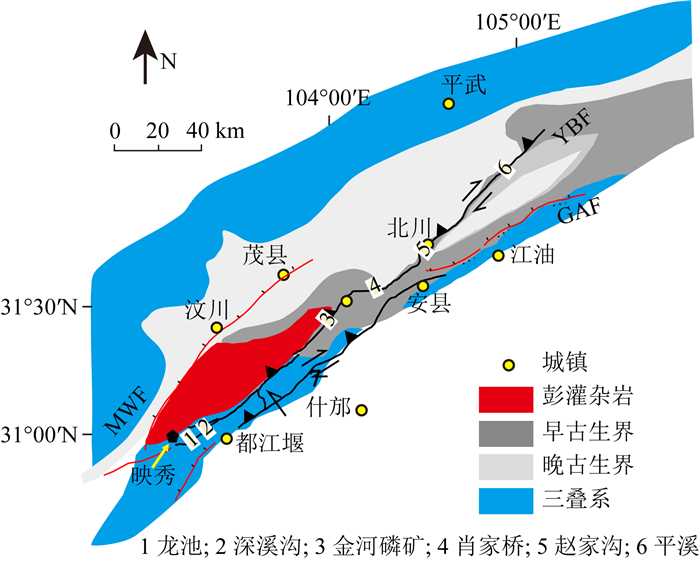
|
图 1 龙门山断裂带地质背景图(据Chen et al., 2013b) 图中标示出了剖面位置, 粗黑线为汶川地震同震地表破碎带.MWF, 茂县—汶川断裂; YBF, 映秀—北川断裂; GAF, 灌县—安县断裂. Fig. 1 Location of the study area and regional geological map of the Longmenshan faultzone (after Chen et al., 2013b) The co-seismic surface ruptures of the Wenchuan earthquake are denoted by thick black lines.MWF, Maoxian-Wenchuan Fault; YBF, Yingxiu-Beichuan Fault; GAF, Guanxian-Anxian Fault. |
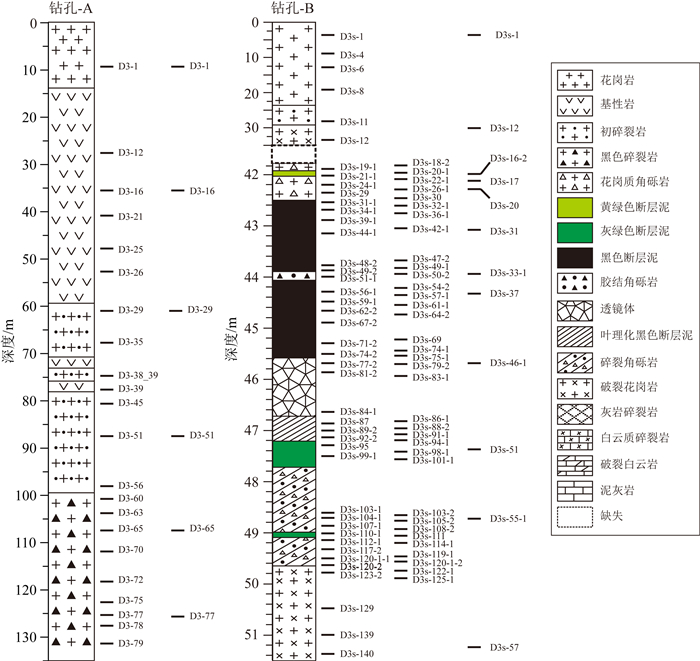
|
图 2 金河磷矿浅钻A孔和B孔柱状图及对应的采样位置(段庆宝, 2015) Fig. 2 Colum section showing the lithologies in borehole-A and B, and the sampling positions (after Duan, 2015) |
对汶川地震断层金河磷矿地表和岩心样品的矿物成分分析表明, 强烈的水-岩相互作用改变了断层带的矿物组成及结构.岩心靠近黄绿色断层泥和灰绿色断层泥, 长石和石英含量下降, 而黏土总量突然上升(图 3), 并且黑色断层泥中长石含量几乎下降至零, 暗示黑色断层泥经历了长时间的水-岩反应, 其中绝大多数长石被分解掉.进一步分析发现:Na2O含量从花岗岩围岩至断层泥发生了明显下降;显微镜下观察表明花岗质角砾岩中的长石发生了明显的蚀变(图 4), 而黑色断层泥中几乎看不到长石的存在.断层主滑动带内积累了较多滑动位移而具有较小的粒度和富集黏土矿物的特征, 滑动带两侧的破碎带内主要富集碎裂矿物.
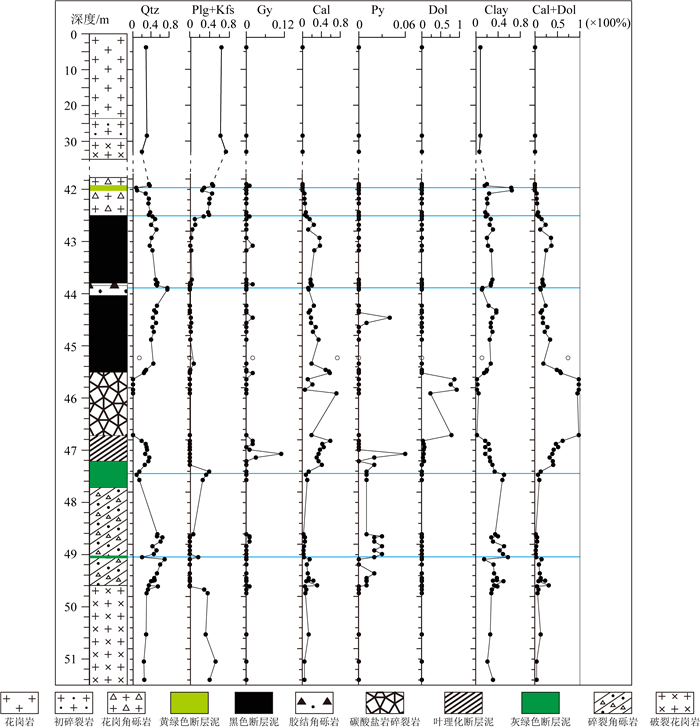
|
图 3 全岩矿物成分分布图(Duan et al., 2016),左侧为岩性柱 矿物含量单位是100%.蓝色线标示断层泥带及主要成分变化.空心圆圈符号表示黑色断层泥层中夹杂的原岩碎屑的分析结果. Qtz, 石英; Plg, 斜长石; Kfs, 钾长石; Gy, 石膏; Cal, 方解石; Py, 黄铁矿; Dol, 白云石; Clay, 黏土总量. Fig. 3 Profiles of the bulk mineral compositions of hole-B with the left column showing the lithology (Duan et al., 2016) The mineral contents are in 100%. The open circles represent the results of a rock clast in the black gouge. Qtz, quartz; Plg, plagioclase; Kfs, K-feldspar; Gy, gypsum; Cal, calcite; Py, pyrite; Dol, dolomite; Clay, total clay. |
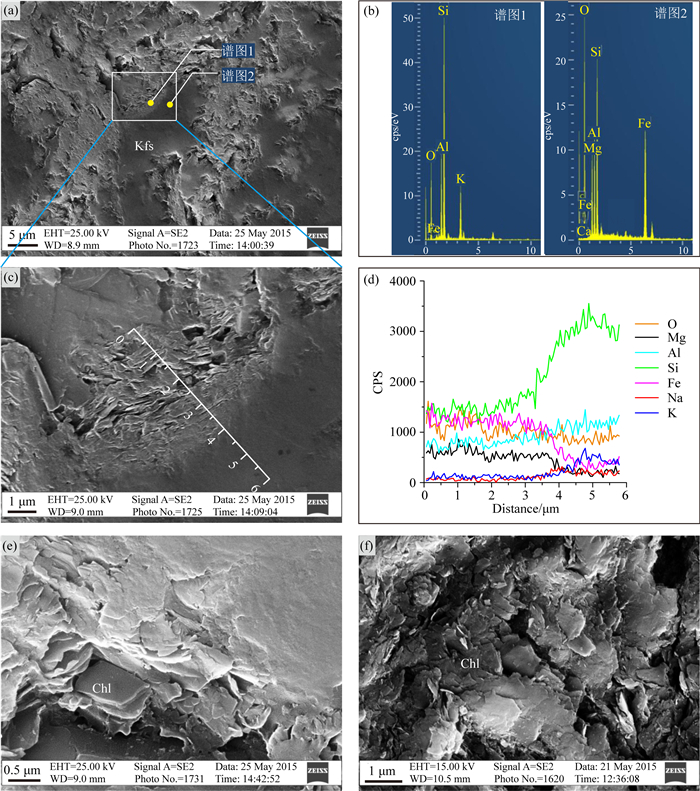
|
图 4 断层泥中钾长石的蚀变分解(段庆宝, 2015) (a) (b)钾长石及颗粒边缘的EDS点分析图; (c)从蚀变矿物到长石颗粒内部的线扫描图; (d)为对应的元素分布图, 可以看出新生成的蚀变矿物具有相对富集Mg和Fe元素的特征.黄绿色断层泥(e)和灰绿色断层(f)中新形成的绿泥石, 大多呈面对面的层状规则分布.图(a), (c), (e)和(f)均为二次电子像. Fig. 4 Alteration of K-feldspars in the gouges (Duan, 2015) (a) (b) EDS analysis of a K-feldspar particle in the yellow-greenish gouge; (c) EDS line scan started from the alteration edge to the center of the K-feldspar particle; (d) The line scanning result of figure (c) showing the elementvariations, Mg and Fe enrichment imply the chloritization.Neoformed chlorite in the yellow-greenish gouge (e) and grey-greenish gouge (f) with face to face contact. |
汶川地震断层核部发现了几种通常形成于热液系统中的矿物(García-Ruiz et al., 2007; Morton et al., 2012), 比如黄铁矿、石膏及坡缕石, 这些矿物在围岩中未曾发现.石膏通常是由地下含硫的流体上涌与地表含氧和钙的流体结合而形成.而坡缕石是一种在碱性条件下不稳定的矿物, 通常容易转化为蒙脱石和方沸石, 另外黄铁矿的大量存在暗示了还原环境.因此, 这些矿物的存在表明流体中富含S, Mg, Fe等离子, 并且Mg, Fe等离子可能来自于镁铁质矿物的蚀变, 水-岩相互作用发生在中酸性还原条件下.
断层带内的层状硅酸盐矿物大多是在流体参与下形成的(Kerrich and Kamineni, 1988).XRD(X-Ray Diffraction, X射线衍射)结果显示, 靠近滑动带, 断层岩中的黏土含量均逐渐升高(黄绿色和黑色断层泥中的黏土总量分别高达65%和37%).黄绿色断层泥和灰绿色断层泥的黏土部分主要由绿泥石、蒙脱石和伊利石组成, 黑色断层泥主要由绿泥石、伊利石和伊/蒙混层所组成.与映秀—北川断层的其他露头相比, 此处的明显特征是富含绿泥石.黄绿色断层泥和黑色断层泥中绿泥石的最大含量分别是47%和13%.另外显微镜下观察也表明从花岗岩原岩到初碎裂岩和黑色碎裂岩, 绿泥石含量有逐渐增加的趋势, 并显示有黑云母等镁铁质矿物蚀变为绿泥石的结构.DES能谱分析表明黄绿色和灰绿色断层泥中的长石发生了明显的绿泥石化蚀变反应.产生绿泥石的方式有两种: 1)由铁镁硅酸盐矿物直接分解而成; 2)由热液带入铁、镁组分发生交代蚀变而成.前人研究表明, 当流体中富含钾离子时同震摩擦生热可以明显促进蒙脱石向伊利石转化(Chen et al., 2013b; Isaacs et al., 2007; Ishikawa et al., 2008).而如果流体中富含Fe2+和Mg2+, 则蒙脱石将会转化为绿泥石(Wintsch et al., 1995).金河磷矿断层带内广泛发育的热液矿物(黄铁矿、石膏及坡缕石等)、方解石脉及黏土矿物的富集表明流体作用非常普遍, 并且富含Fe2+和Mg2+.这解释了该剖面中绿泥石大量富集的现象.Wintsch等(1995)用“流体活动图”探讨了这一过程, 在酸性条件水主导的花岗质体系中, 长石会被逐渐分解并生成层状硅酸盐矿物(如高岭石、云母等).如果上述系统有Mg2+离子加入, 则将会有绿泥石生成.地震活动导致周期性循环注入的大气降水与围岩持续反应生成绿泥石等矿物.与其他黏土矿物(如蒙脱石、伊利石、高岭石等)相比, 绿泥石能够稳定存在的温度范围可高达300 ℃以上(Suchecki et al., 1977; Robinson et al., 2002; Schleicher et al., 2012), 远高于蒙脱石、伊利石及伊/蒙混层等稳定温度范围(80~200 ℃) (Hoffman and Hower, 1979; Velde et al., 1986).依据龙门山地区的地表热流值为55.3 mW·m-2(Wang, 1996)估算, 绿泥石存在深度可达16 km, 因此, 我们认为震源区断层带黏土矿物有可能富集绿泥石.绿泥石在汶川地震的成核过程中的作用值得深究.
1.2 汶川地震断层带元素富集与亏损特征通常将断层岩中相对原岩亏损的元素称为D-型元素, 相对富集的元素称为R-型元素(Tanaka et al., 2001; Chen et al., 2013b).本研究结果表明R-型元素主要包括Mg、P5、Ca、Ti、Mn、Fe;Na和Si属于D-型元素.除了Ba和Sr外, 大多数微量元素属于R-型.上述研究结果与前人有关花岗质断层带的研究结果基本一致(如,Goddard and Evans, 1995; Tanaka et al., 2001).前人研究表明, TiO2, P2O5, MnO及Rb等在断层带中最为稳定, 因而容易在断层带内富集(O′Hara, 1988; Goddard and Evans, 1995; Tanaka et al., 2001).对映秀—北川断裂金河磷矿剖面的研究显示(Duan et al., 2016),除了黑色断层泥中的几个碳酸盐岩相关的元素之外, 花岗岩原岩、破裂的花岗岩、黑色碎裂岩、花岗质角砾岩及黑色断层泥的元素分布表现出一致的变化趋势.向断层核部方向, 与长石等矿物相关的元素均表现为亏损, 其他元素基本都是富集.黄绿色和灰绿色断层泥的组成由于基性岩成分的加入而发生了较大变化, 但是整体的元素分布规律仍然表现为流体淋滤的基本特征, 即活动性强的元素大多亏损, 相对稳定的元素多发生富集.
元素相关性分析表明, TiO2与其他稳定性元素之间大多呈明显的正相关的线性关系, 与不稳定性元素(主要是长石相关的元素, 如Si, K, Na)大多呈负相关关系, 因此, TiO2可以作为可靠的标记性元素来评价断层带内的物质流失情况.在Isocon图中(图 5), 位于斜率为1的线下方的元素是D型元素, 之上的元素为R型.大多数稳定性元素(如P2O5, Nb, V, Co和Sc)都紧密分布在TiO2所定义的浓度等值线附近.相对于花岗岩围岩, Isocon线的斜率均大于1, 表明整体物质发生流失.原岩成分采用来自断层上盘的4个新鲜未蚀变的花岗岩样品的平均值.对岩心结果的细致分析可以看出, 黑色碎裂岩的斜率最小, 为1.09;花岗质角砾岩和黑色断层泥具有相对较大的斜率, 分别是2.25和3.08.这与地表断层岩的计算的结果接近.黄绿色和灰绿色断层泥中混入了基性岩的成分, 尤其是混入了较多的R型元素, 故未计算其物质流失量.计算表明, 相对于花岗岩围岩黑色碎裂岩的体积流失量最小, 大约是7.6%(图 5a);花岗质角砾岩和黑色断层泥的流失量分别是43.0%和54.6% (图 5b, 5c).与平溪和赵家沟剖面的研究相比(Chen et al., 2013b), 金河磷矿断层带的流失量偏小, 但是与前人无论是沉积岩断层带(Schleicher et al., 2009)还是花岗质断层带(Goddard and Evans, 1995; Tanaka et al., 2001)的研究相比, 均明显偏大.这表明映秀—北川断层带经历了更显著的流体-岩石相互作用及压实过程.前人提出了多种断层带物质的流失机制:溶解(Chen et al., 2007), 应力导致的颗粒接触点溶解(Schleicher et al., 2009), 压溶(De Meer et al., 1997;Holdsworth et al., 2011)及碳酸盐岩矿物的热分解(如,Han et al., 2007; Sulem and Famin, 2009; Collettini et al., 2013)等.无论哪种机制占主导, 断层带物质大量流失主要反映的是持续的水-岩相互作用的综合结果(Caine et al., 1996; Seront et al., 1998; Caine and Forster, 1999; Chen et al., 2007).
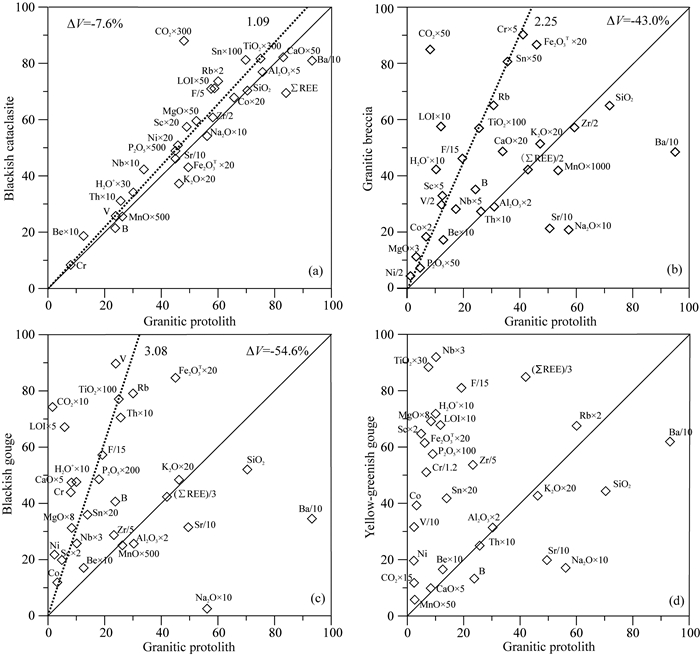
|
图 5 Isocon等值线图(Duan et al., 2016) 主元素单位是wt.%, 微量元素是ppm.虚线是由TiO2定义的Isocon线; 实线是浓度平衡线; ΔV(%)代表估算的体积流失量. Fig. 5 Grant-type plot of the average composition of the granite protolith against the average composition of the fault rocks (Duan et al., 2016) The concentrations are noted for major elements in wt.% and trace elements in ppm, and scaled to the plot.The dashed lines are the isocon lines defined by TiO2; the solid lines are the mass equilibrium lines, and ΔV(%) is the estimated percentage of volume loss. |
绝大多数地震断层带具有富集黏土矿物的特征.研究表明利用气体和流体作为介质测量断层岩的输运特征存在很大的差异, 并且其差异并不能通过Klinkenberg校正得以消除(Duan and Yang, 2014).推断造成上述不一致的原因可能来自于黏土矿物的亲水性所引起的有效孔隙尺寸下降(Faulkner and Rutter, 2000).这不仅影响到断层带渗透率基本特性的认识, 基于断层岩输运参数所做其他研究结果也可能出现偏差, 因此查明其原因至关重要.
初步实验结果显示, 饱水后含黏土矿物样品的液体渗透率下降幅度可达约2个数量级(图 6).对比利用干燥条件气体和利用液体测量得到的连通孔隙度发现, 其二者存在着明显差异(图 6).含有黏土矿物样品的孔隙度在饱水后均发生了不同程度的降低, 并且随着黏土矿物含量的升高, 液体孔隙度下降幅度逐渐增大.而不含黏土矿物的砂岩样品, 其液体孔隙度与气体孔隙度基本一致.表明含黏土矿物饱水后孔隙度减小是导致渗透率偏低的重要原因, 而孔隙度下降与样品中的蒙脱石吸水膨胀和黏土矿物颗粒表面吸附孔隙流体密切相关.

|
图 6 气体和液体介质测量得到的渗透率(黑色)和孔隙度(蓝色)实验结果对比 黑色为渗透率对应左侧坐标轴, 蓝色为孔隙度对应右侧坐标轴;虚线为气体结果, 实线为水测得的结果. Fig. 6 Comparison of gas and water permeability (black) and porosity (blue) of gouge The dashed lines are gas results and solidslines are water results. |
断层带通常由断层核部、破碎带及相对完整的围岩所组成(Caine et al., 1996; Faulkner et al., 2010; Holdsworth et al., 2011).横跨断层带渗透率表现出近似呈“M”型分布, 即核部断层泥和围岩的渗透率介于10-20~10-22 m2之间(165 MPa有效压力下), 而夹于断层泥和围岩之间的断层角砾岩具有较高的渗透率(10-17~10-20 m2之间)(图 7a).跨断层相应的孔隙度和黏土含量分布则表现出断层泥带明显高于两侧的断层角砾岩和围岩(图 7b、7c).这个特征在汶川地震多个剖面研究中得到证实, 也与前人研究结果类似(如, Caine et al., 1996; Evans et al., 1997; Lockner et al., 2000; Mizoguchi et al., 2008; 陈建业等, 2011).两侧破碎带渗透率相对较高, 整体表现为近似“M”型的渗透性结构.这与Caine等(1996)提出的“通道/障碍体”模型基本一致.因此, 横跨断层带渗透率总体表现出宏观各向异性, 核部断层泥低渗透性阻碍使得流体更倾向平行于断层面方向迁移.需要指出的是, 金河磷矿岩心剖面核部的渗透率明显低于前人的研究结果.其原因可能与样品(如黑色断层泥), 经历过较长时间的水-岩相互作用、压实作用、热液矿物沉淀、胶结作用有关.另一个重要的原因可能与采用的测量方法不同.如前所述, 气体作为介质进行的渗透率测量无法消除由于黏土膨胀和吸附作用对渗透率产生的影响.由此可见, 在研究断层带这种富含黏土矿物的输运特性时, 选择气体作为测量介质并不合适.
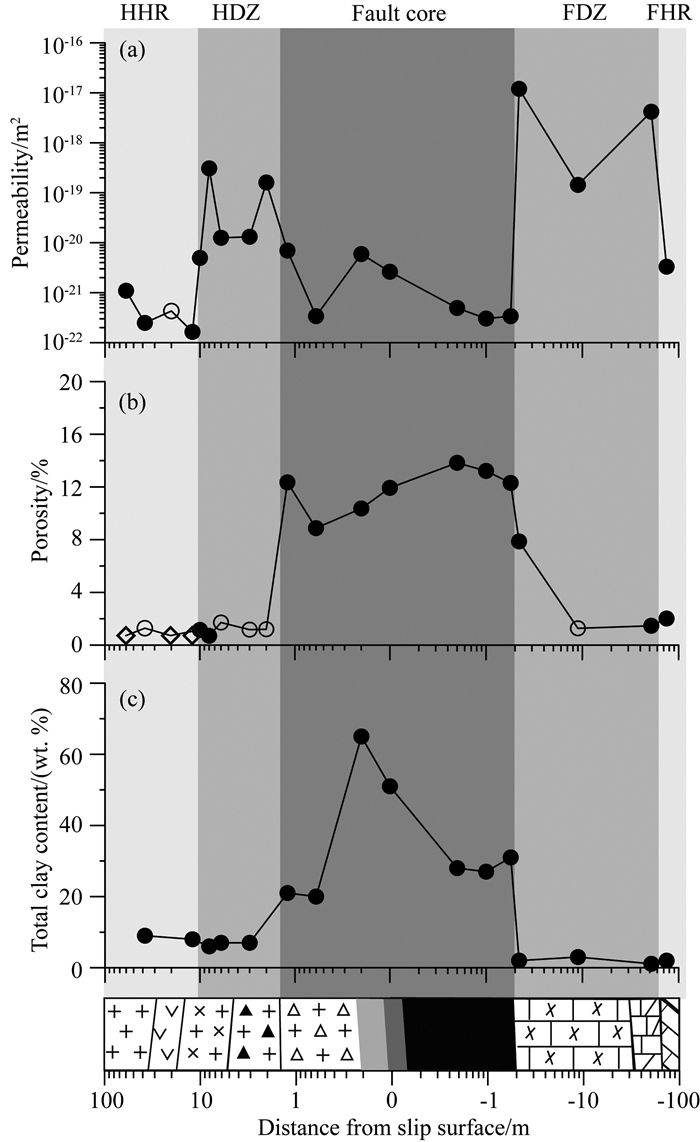
|
图 7 金河磷矿渗透率(a)、孔隙度(b)及黏土矿物含量(c)剖面图(据Duan et al., 2017) 图中横坐标为断层剖面上距离滑动面的距离, 对应的素描图为地表断层带剖面.HHR, 上盘围岩; HDZ, 上盘破碎带; FDZ, 下盘破碎带; FHR, 下盘围岩. Fig. 7 Profiles of permeability (a), porosity (b) and clay content (c) across the Golden River outcrop (after Duan et al., 2017) HHR, hanging wall host rock; HDZ, hanging wall damage zone; FDZ, footwall damage zone; FHR, footwall host rock. |
地震破裂带高孔隙度的特征以及富含黏土矿物导致其弹性波速度与结晶岩石和沉积岩存在明显的差异.确定断层岩的弹性波速度与孔隙度和矿物组成的关系对于利用地震资料探测深部断层和测井资料的解释至关重要.杨彧等(2014)研究结果表明, 在600 MPa的压力范围内, VP随着压力的增高呈现对数增加, 其增长率随着压力的上升而逐渐减小;断层岩中的孔隙度随着压力的增高呈对数减小.即便围压高达1000 MPa, 断层岩中仍然可以残留可观的孔隙量.这与固结的岩石(结晶岩石和沉积岩)的特点存在明显区别.固结的岩石, 尤其是沉积岩往往存在一个临界围压(通常介于300~500 MPa), 当围压高于临界压力时, 岩石中的孔隙将关闭, 岩石的弹性波速度随围压的升高而线性增加.分析显示, 断层岩纵波速度与孔隙度遵从线性负相关关系(孔隙度<20%), 即
利用地震断层岩的模拟样品(50%石英+50%蒙脱石)开展更为精细的实验研究, 获得了VP与总黏土含量和总孔隙度在50%变化范围内的协变关系(图 8).总孔隙度变化在50%范围内, 其VP偏离了线性关系, 即在高孔隙度条件下, 纵波速度随孔隙度增加而下降的幅度有可能变小.
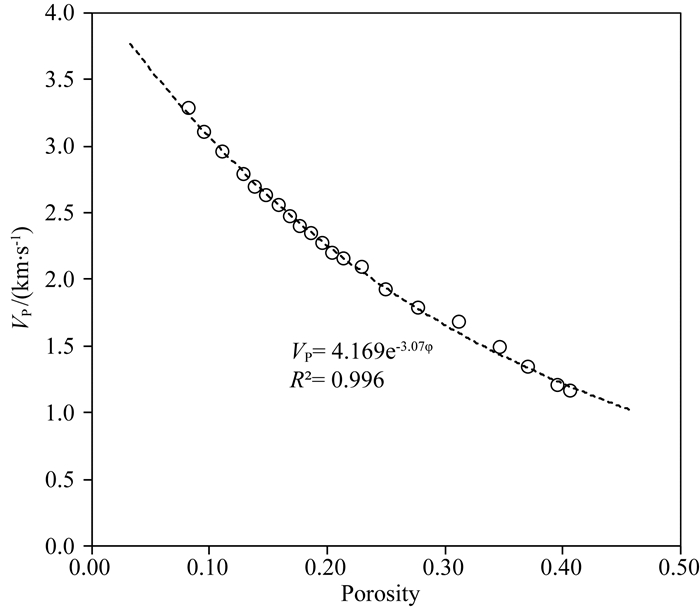
|
图 8 断层岩纵波速度与总孔隙度的关系 Fig. 8 Relationship between VP and total porosity of fault rocks |
地震破裂过程是导致断层岩颗粒细化的重要原因, 因而断层岩的粒度被认为是揭示地震碎裂过程和地震能量分配的重要参数(Sammis, 1986; Zhao et al., 1990;Hooke and Iverson, 1995;Wilson et al., 2005;Ma et al., 2006).陈建业等(2014)对汶川地震断层带粒度的研究显示, 断层岩的粒度分布并不具有自相似性特征, 反映出断层带内的颗粒细粒化过程具有复杂的机制, 并不仅仅是地震过程中机械破裂的产物.杨晓松等(2014)初步的研究结果显示断层岩矿物成分与碎屑粒径密切相关, 即随着粒径的减小, 其黏土矿物含量逐渐增高;粒径小于1 μm的矿物绝大多数为黏土矿物, 在较粗粒径中大量存在的石英、长石等造岩矿物的含量极低或几乎不存在.由于黏土矿物是在地震间震期通过水岩相互作用形成, 因此其与地震破裂本身关系不大, 另一方面, 在地震滑动中破裂形成的岩屑通过水岩相互作用蚀变和流失, 矿物碎屑的含量及其粒度分布也会随着时间的推移而发生变化.因此, 地震断层岩的粒度分布特征不能作为度量地震破裂能的参数.
3 汶川地震断层带的水岩相互作用讨论龙门山断裂带经历了长时间的隆升及多期次的强震活动(Zhang et al., 2010; Ran et al., 2010, 2013).从结构上看, 形成于不同深度的固结和非固结的岩石常出现在同一个断层带剖面中, 例如金河磷矿地表和岩心剖面(图 2)中均包含固结的碎裂岩和松散的角砾岩及断层泥.这暗示目前在地表或岩心中见到的断层岩是由多期次的地震滑动及震后长时间断层蠕滑并伴随着隆升与剥蚀等作用的综合产物.从矿物组成上看, 断层泥或角砾岩中既有来自不同原岩的岩石碎屑(机械破碎产物)又有通过水岩相互作用形成的蚀变或新生矿物.显示出断层岩的形成经历了漫长的时间和复杂的过程.流体来源于两个方面, 其一, 地表径流沿断层破碎带不断地下渗;其二, 在地震的“开关”作用下, 深部高压流体沿着地震断层带上涌.流体在断层带内活动留下一系列能够揭示其成因的线索.与地表径流相关的现象包括:断层泥附近的角砾岩显示出的强淋滤特征, 具有高磁化率并有淋滤矿物埃洛石产出(陈建业等, 2011).伊蒙混层或伊利石矿物形成与热水活动相关, 当流体富含Mg2+和Fe2+离子时, 则利于绿泥石的形成;断层泥中含有典型的热水矿物如重晶石、硬石膏、黄铁矿及坡缕石等是深部高压流体活动的直接证据.断层带内大量发育的不同尺度的方解石脉和(或)石英脉不仅揭示了流体活动, 同时也说明间震期流体活动是断层带愈合的重要机制.脉体间的切割关系显示出流体活动具有多期次的特点, 而断层泥中含有各种脉体的碎屑表明地震断层滑动倾向追踪早期的滑动面.断层核部大量物质流失是断层带流体活动另一种表现, 物质流失不仅造成断层带体积的巨大变化, 也彻底改变了其成分, 尤其是断层带核部的化学组成.断层带内流体综合作用如图 9所示.流体活动及其伴随的可溶性元素溶解、迁移造成大量物质流失.溶解-沉淀及压溶作用是断层带物质流失的主要机制.断层主滑动带较破碎带相对偏高的物质流失量及相对富集新生黏土矿物主要是由于主滑动带断层岩经历了强烈的断层滑动破碎作用而具有较低的粒度分布和较强的水岩反应, 并且经历了同震摩擦升温等作用的影响.因此, 机械破碎和水岩相互作用是改变并控制断层带内物质组成与结构演化的重要机制.

|
图 9 断层带流体作用的物理化学过程综合模型(据Duan et al., 2016) Fig. 9 Conceptual model coupling mechanical-geochemical processes illustrating the fluid infiltration and geochemical evolutions of the fault zone (after Duan et al., 2016) |
切割不同围岩的断层带, 其断层岩中元素的相对亏损与富集规律存在差别.碳酸盐岩断层带中亏损的元素多是Ca等元素, 碎屑沉积岩及结晶岩系中亏损的元素多是与长石相关, 如包括Na, Al, Si, K等元素.对汶川地震断层带化学组成的研究表明, 当围岩为碳酸盐岩时, 其流失的元素主要为CaO、MgO、CO2及一些微量元素(Chen et al., 2013b);而当围岩是花岗岩时, 其显著亏损的为Na2O和SiO2(Duan et al., 2016).
实验结果表明, 至少在600 MPa(~25 km)以内地震断层内部仍然残留大量的孔隙.高孔隙度的存在与断层岩的碎屑结构有关.碎屑矿物构建的格架结构承受围压, 使得分布于颗粒格架间隙中的孔隙得以保存.格架矿物的粒径越大, 其间的孔隙尺度也越大, 渗透性越好.相反, 如断层核部的断层泥, 其渗透性很低, 但是其孔隙度相对较高.相比结晶岩石, 断层破碎带的渗透率高2~4数量级.从断层带孔隙度和渗透率实验结果分析, 在汶川地震震源深度范围内, 水库蓄水具有向断层带深部渗流, 并有可能在深部形成高流体孔隙压的条件(杨彧等, 2015).
除了间震期发生的水岩相互作用外, 同震阶段的摩擦升温也可能导致矿物在短时间内发生突变.这个过程主要涉及到含水黏土矿物向无水黏土矿物的转化.蒙脱石向伊利石转化是最典型的例子.对台湾集集地震断层滑动带矿物分析显示, 断层滑动带的高岭石和蒙脱石的含量明显低于周围岩石, 而伊利石含量相对增加, 暗示同震过程中发生了伊利石化过程(Hirono et al., 2008).同样的现象也见于汶川地震断层带中(Chen et al., 2013b).尽管同震过程中蒙脱石向伊利石转化发生在很窄的范围内(数厘米), 但其可以作为地震破裂滑动带的重要标志.另一方面, 同震矿物转化伴随着脱水或脱气(Roland and Ola, 1996;Hirono et al., 2006; Mishima et al., 2006; Han et al., 2007;Hirose and Bystricky, 2007; Brantut et al., 2011;Lin et al., 2013).当地震断层滑动带的渗透率足够低时, 矿物脱水或脱气可能引起断层滑动带局域流体孔隙压的急剧升高(同震热压作用), 导致断层带显著地滑动弱化.研究表明, 汶川地震断裂带普遍存在同震热压作用引起的滑动弱化现象(Chen et al., 2013a, 2013c, 2016;Duan et al., 2017).
4 结论(1) 强烈的水-岩相互作用显著地改变了断层带的矿物组成及结构.组成断层岩的矿物由原岩碎屑与在水岩相互作用中生成的矿物混合物, 其中长石等造岩矿物含量大幅下降, 黏土矿物含量大幅增加.地表径流和深部高压流体是两个流体来源.断层岩的形成经历了漫长的时间和机械破碎及水岩相互作用复杂的过程.机械破碎和水岩相互作用是改变并控制断层带内物质组成与结构演化的重要机制.
(2) 断层岩的渗透性具有强烈的不均匀性, 不同类型的断层岩渗透率变化达到5~6个量级;跨断层带渗透性表现出显著的各向异性, 导致垂直断层带方向流体迁移受限.颗粒支撑结构使得即便在围压高达600 MPa条件下, 断层岩中依旧含有大量的孔隙, 这为流体沿断层带下渗、水岩相互作用、断层带愈合、诱发深部流体孔隙压的形成等作用提供了条件.
(3) 断层岩的气体渗透率远高于液体渗透率.造成二者差异的原因除了Klinkengberg效应外, 更重要的因素是黏土矿物遇水膨胀和对水分子的吸附.因此, 研究断层带这种富含黏土矿物的输运特性时, 气体作为测量介质并不合适.干燥断层岩的纵波速度显著低于围岩并随黏土矿物的含量和孔隙的增加而减小.
(4) 鉴于断层岩中极细的矿物碎屑在破裂能计算中贡献最大, 而细小颗粒矿物绝大多数是间震期水岩相互作用的产物, 与地震破裂没有直接关系, 因此, 地震断层岩的粒度分布特征不能作为度量地震破裂能的参数.地震滑动摩擦生热所导致矿物快速脱水和(或)脱气可能引起断层滑动带局域流体孔隙压的急剧升高(同震热压作用), 并引起断层带显著地滑动弱化.
致谢本文内容涉及到近十年以来我们在汶川地震断层水岩相互作用方面所开展的研究.在此过程中, 尤其是在野外调查和实施浅钻工程中, 得到了中国地震局地质研究所构造物理实验室很多科研与技术人员及研究生的帮助, 在此一并感谢.
Bradbury K K, Davis C R, Shervais J W, et al.
2015. Composition, alteration, and texture of fault-related rocks from SAFOD core and surface outcrop analogs: Evidence for deformation processes and fluid-rock interactions. Pure and Applied Geophysics, 172(5): 1053-1078.
DOI:10.1007/s00024-014-0896-6 |
|
Brantley S L, Evans B, Hickman S H, et al.
1990. Healing of microcracks in quartz: Implications for fluid flow. Geology, 18(2): 136-139.
DOI:10.1130/0091-7613(1990)018<0136:HOMIQI>2.3.CO;2 |
|
Brantut N R, Han T, Shimamoto N, et al.
2011. Fast slip with inhibited temperature rise due to mineral dehydration: Evidence from experiments on gypsum. Geology, 39(1): 59-62.
DOI:10.1130/G31424.1 |
|
Byerlee J D.
1993. Model for episodic flow of high-pressure water in fault zones before earthquakes. Geology, 21(4): 303-306.
DOI:10.1130/0091-7613(1993)021<0303:MFEFOH>2.3.CO;2 |
|
Caine J S, Evans J P, Forster C B.
1996. Fault zone architecture and permeability structure. Geology, 24(11): 1025-1028.
DOI:10.1130/0091-7613(1996)024<1025:FZAAPS>2.3.CO;2 |
|
Caine J S, Forster C B. 1999. Fault zone architecture and fluid flow: Insights from field data and numerical modeling. //Haneberg W C, Mozley P S, Moore J C, eds. Faults and Subsurface Fluid Flow in the Shallow Crust. Washington, D. C: Geophysical Monograph Series, 113: 101-127, doi: 10.1029/GM113p0101.
|
|
Chen J Y, Yang X S, Dang J X, et al.
2011. Internal structure and permeability of Wenchuan earthquake fault. Chinese Journal of Geophysics, 54(7): 1805-1816.
DOI:10.3969/j.issn.0001-5733.2011.07.014 |
|
Chen J Y, Yang X S, Duan Q B, et al.
2013a. Importance of thermochemical pressurization in the dynamic weakening of the Longmenshan fault during the 2008 Wenchuan earthquake: Inferences from experiments and modeling. Journal of Geophysical Research: Solid Earth, 118(8): 4145-4169.
DOI:10.1002/jgrb.50260 |
|
Chen J Y, Yang X S, Ma S L, et al.
2013b. Mass removal and clay mineral dehydration/rehydration in carbonate-rich surface exposures of the 2008 Wenchuan Earthquake fault: Geochemical evidence and implications for fault zone evolution and coseismic slip. Journal of Geophysical Research: Solid Earth, 118(2): 474-496.
DOI:10.1002/jgrb.50089 |
|
Chen J Y, Yang X S, Yao L, et al.
2013c. Frictional and transport properties of the 2008 Wenchuan Earthquake fault zone: Implications for coseismic slip-weakening mechanisms. Tectonophysics, 603: 237-256.
DOI:10.1016/j.tecto.2013.05.035 |
|
Chen J Y, Yang X S.
2014. Characteristics of particle size distribution of the Wenchuan earthquake fault zone: Insights for cataclastic mechanisms. Seismology and Geology, 36(2): 368-379.
|
|
Chen J Y, Yang X S, Ma S L, et al.
2016. Hydraulic properties of samples retrieved from the Wenchuan earthquake Fault Scientific Drilling Project hole-1 (WFSD-1) and the surface rupture zone: Implications for coseismic slip weakening and fault healing. Geochemistry, Geophysics, Geosystems, 17(7): 2717-2744.
DOI:10.1002/2016GC006376 |
|
Chen WM D, Tanaka H, Huang H J, et al.
2007. Fluid infiltration associated with seismic faulting: Examining chemical and mineralogical compositions of fault rocks from the active Chelungpu fault. Tectonophysics, 443(3-4): 243-254.
DOI:10.1016/j.tecto.2007.01.025 |
|
Collettini C, Viti C, Tesei T, et al.
2013. Thermal decomposition along natural carbonate faults during earthquakes. Geology, 41(8): 927-930.
DOI:10.1130/G34421.1 |
|
De Meer S, Spiers C J, Peach C J.
1997. Pressure solution creep in gypsum: Evidence for precipitation reaction control. Physics and Chemistry of the Earth, 22(1-2): 33-37.
DOI:10.1016/S0079-1946(97)00074-8 |
|
Duan Q B, Yang X S.
2014. Experimental studies on gas and water permeability of fault rocks from the rupture of the 2008 Wenchuan earthquake, China. Science China Earth Sciences, 57(11): 2825-2834.
DOI:10.1007/s11430-014-4948-7 |
|
Duan Q B. 2015. Geochemical and petrophysical responses to fluid processes within seismogenic fault zone: Exemplified by a granitic rupture zone on the Longmenshan Fault [Ph. D. thesis] (in Chinese). Institute of Geology, China Earthquake Administration.
|
|
Duan Q B, Yang X S, Ma S L, et al.
2016. Fluid-rock interactions in seismic faults: Implications from the structures and mineralogical and geochemical compositions of drilling cores from the rupture of the 2008 Wenchuan earthquake, China. Tectonophysics, 666: 260-280.
DOI:10.1016/j.tecto.2015.11.008 |
|
Duan Q B, Yang X S, Chen J Y.
2017. Hydraulic properties of a low permeable rupture zone on the Yingxiu-Beichuan Fault activated during the Wenchuan earthquake, China: Implications for fluid conduction, fault sealing, and dynamic weakening mechanisms. Tectonophysics, 721: 123-142.
DOI:10.1016/j.tecto.2017.10.002 |
|
Evans J P, Chester F M.
1995. Fluid-rock interaction in faults of the San Andreas system: Inferences from San Gabriel fault rock geochemistry and microstructures. Journal of Geophysical Research: Solid Earth, 100(B7): 13007-13020.
DOI:10.1029/94JB02625 |
|
Evans J P, Forster C B, Goddard J V.
1997. Permeability of fault-related rocks, and implications for hydraulic structure of fault zones. Journal of Structural Geology, 19(11): 1393-1404.
DOI:10.1016/S0191-8141(97)00057-6 |
|
Faulkner D R, Rutter E H.
2000. Comparisons of water and argon permeability in natural clay-bearing fault gouge under high pressure at 20℃. Journal of Geophysical Research: Solid Earth, 105(B7): 16415-16426.
DOI:10.1029/2000JB900134 |
|
Faulkner D R, Rutter E H.
2003. The effect of temperature, the nature of the pore fluid, and subyield differential stress on the permeability of phyllosilicate-rich fault gouge. Journal of Geophysical Research: Solid Earth, 108(B5): 2227.
DOI:10.1029/2001JB001581 |
|
Faulkner D R, Jackson C A L, Lunn R J, et al.
2010. A review of recent developments concerning the structure, mechanics and fluid flow properties of fault zones. Journal of Structural Geology, 32(11): 1557-1575.
DOI:10.1016/j.jsg.2010.06.009 |
|
García-Ruiz J M, Villasuso R, Ayora C, et al.
2007. Formation of natural gypsum megacrystals in Naica, Mexico. Geology, 35(4): 327-330.
DOI:10.1130/G23393A.1 |
|
Goddard J V, Evans J P.
1995. Chemical changes and fluid-rock interaction in faults of crystalline thrust sheets, northwestern Wyoming, U.S.A. Journal of Structural Geology, 17(4): 533-547.
DOI:10.1016/0191-8141(94)00068-B |
|
Han R, Shimamoto T, Hirose T, et al.
2007. Ultralow friction of carbonate faults caused by thermal decomposition. Science, 316(5826): 878-881.
DOI:10.1126/science.1139763 |
|
He C H, Wang Z L, Yao W M.
2007. Frictional sliding of gabbro gouge under hydrothermal conditions. Tectonophysics, 445(3-4): 353-362.
DOI:10.1016/j.tecto.2007.09.008 |
|
Hirono T, Ikehara M, Otsuki K, et al.
2006. Evidence of frictional melting from disk-shaped black material, discovered within the Taiwan Chelungpu fault system. Geophysical Research Letters, 33(19): L19311.
DOI:10.1029/2006GL027329 |
|
Hirono T, Fujimoto K, Yokoyama T, et al.
2008. Clay mineral reactions caused by frictional heating during an earthquake: An example from the Taiwan Chelungpu fault. Geophysical Research Letters, 35(16): L16303.
DOI:10.1029/2008GL034476 |
|
Hirose T, Bystricky M.
2007. Extreme dynamic weakening of faults during dehydration by coseismic shear heating. Geophysical Research Letters, 34(14): L14311.
DOI:10.1029/2007GL030049 |
|
Hoffman J, Hower J.
1979. Clay mineral assemblages as low grade metamorphic geothermometers: Application to the thrust faulted disturbed belt of Montana, U.S.A.. SEPM Special Publication, 26: 55-79.
|
|
Holdsworth R E, Van Diggelen E W E, Spiers C J, et al.
2011. Fault rocks from the SAFOD core samples: Implications for weakening at shallow depths along the San Andreas Fault, California. Journal of Structural Geology, 33(2): 132-144.
DOI:10.1016/j.jsg.2010.11.010 |
|
Hooke R L, Iverson N R.
1995. Grain-size distribution in deforming subglacial tills: Role of grain fracture. Geology, 23(1): 57-60.
DOI:10.1130/0091-7613(1995)023<0057:GSDIDS>2.3.CO;2 |
|
Isaacs A J, Evans J P, Song S R, et al.
2007. Structural, mineralogical, and geochemical characterization of the Chelungpu thrust fault, Taiwan. Terrestrial, Atmospheric and Oceanic Sciences, 18(2): 183-221.
DOI:10.3319/TAO.2007.18.2.183(TCDP) |
|
Ishikawa T, Tanimizu M, Nagaishi K, et al.
2008. Coseismic fluid-rock interactions at high temperatures in the Chelungpu fault. Nature Geoscience, 1(10): 679-683.
DOI:10.1038/ngeo308 |
|
Kerrich R, Kamineni D C.
1988. Characteristics and chronology of fracture—fluid infiltration in the Archean, Eye Dashwa Lakes pluton, Superior Province: Evidence from H, C, O-isotopes and fluid inclusions. Contributions to Mineralogy and Petrology, 99(4): 430-445.
DOI:10.1007/BF00371935 |
|
Lin A M, Takano S, Hirono T, et al.
2013. Coseismic dehydration of serpentinite: Evidence from high-velocity friction experiments. Chemical Geology, 344: 50-62.
DOI:10.1016/j.chemgeo.2013.02.013 |
|
Lockner D A, Naka H, Tanaka H, et al. 2000. Permeability and strength of core samples from the Nojima fault of the 1995 Kobe earthquake. //Proceedings of the International Workshop on the Nojima Fault Core and Borehole Data Analysis. Tsukuba: U. S. Geology Survey, 22-23.
|
|
Ma K F, Tanaka H, Song S R, et al.
2006. Slip zone and energetics of a large earthquake from the Taiwan Chelungpu-fault Drilling Project. Nature, 444(7118): 473-476.
DOI:10.1038/nature05253 |
|
Matsuda T, Omura K, Ikeda R, et al.
2004. Fracture-zone conditions on a recently active fault: Insights from mineralogical and geochemical analyses of the Hirabayashi NIED drill core on the Nojima fault, southwest Japan, which ruptured in the 1995 Kobe earthquake. Tectonophysics, 378(3-4): 143-163.
DOI:10.1016/j.tecto.2003.09.005 |
|
Mishima T, Hirono W, Soh S, et al.
2006. Thermal history estimation of the Taiwan Chelungpu fault using rock-magnetic methods. Geophysical Research Letters, 33(23): L23311.
DOI:10.1029/2006GL028088 |
|
Mizoguchi K, Hirose T, Shimamoto T, et al.
2008. Internal structure and permeability of the Nojima fault, southwest Japan. Journal of Structural Geology, 30(4): 513-524.
DOI:10.1016/j.jsg.2007.12.002 |
|
Moore D E, Lockner D A. 2007. Friction of the smectite clay montmorillonite: A review and interpretation of data. //Dixon T, Moore J C eds. The Seismogenic Zone of Subduction Thrust Faults. New York: Columbia University Press, 317-345.
|
|
Morrow C A, Shi L Q, Byerlee J B.
1981. Permeability and strength of San Andreas fault gouge under high pressure. Geophysical Research Letters, 8(4): 325-328.
DOI:10.1029/GL008i004p00325 |
|
Morton N, Girty G H, Rockwell T K.
2012. Fault zone architecture of the San Jacinto fault zone in Horse Canyon, southern California: A model for focused post-seismic fluid flow and heat transfer in the shallow crust. Earth and Planetary Science Letters, 329-330: 71-83.
DOI:10.1016/j.epsl.2012.02.013 |
|
O'Hara K.
1988. Fluid flow and volume loss during mylonitization: An origin for phyllonite in an overthrust setting, North Carolina U.S.A. Tectonophysics, 156(1-2): 21-36.
DOI:10.1016/0040-1951(88)90280-6 |
|
Polak A, Elsworth D, Yasuhara H, et al.
2003. Permeability reduction of a natural fracture under net dissolution by hydrothermal fluids. Geophysical Research Letters, 30(20): 2020.
DOI:10.1029/2003GL017575 |
|
Ran Y K, Chen L C, Chen J, et al.
2010. Paleoseismic evidence and repeat time of large earthquakes at three sites along the Longmenshan fault zone. Tectonophysics, 491(1-4): 141-153.
DOI:10.1016/j.tecto.2010.01.009 |
|
Ran Y K, Chen W S, Xu X W, et al.
2013. Paleoseismic events and recurrence interval along the Beichuan-Yingxiu fault of Longmenshan fault zone, Yingxiu, Sichuan, China. Tectonophysics, 584: 81-90.
DOI:10.1016/j.tecto.2012.07.013 |
|
Rice J R. 1992. Fault stress states, pore pressure distributions, and the weakness of the San Andreas fault. //Evans B, Wong T F eds. Fault Mechanics and Transport Properties of Rocks. London: Academic Press, 475-503.
|
|
Robinson D, Schmidt S T, Zamora D, et al.
2002. Reaction pathways and reaction progress for the smectite-to-chlorite transformation: Evidence from hydrothermally altered metabasites. Journal of Metamorphic Geology, 20(1): 167-174.
DOI:10.1046/j.0263-4929.2001.00361.x |
|
Roland P, Ola K.
1996. Physico/chemical stability of smectite clays. Engineering Geology, 41(1-4): 73-85.
DOI:10.1016/0013-7952(95)00027-5 |
|
Sammis C G, Osborne R H, Anderson J L, et al.
1986. Self-similar cataclasis in the formation of fault gouge. Pure and Applied Geophysics, 124(1-2): 53-78.
DOI:10.1007/BF00875719 |
|
Schleicher A M, Tourscher S N, Van Der Pluijm B A, et al.
2009. Constraints on mineralization, fluid-rock interaction, and mass transfer during faulting at 2-3 km depth from the SAFOD drill hole. Journal of Geophysical Research: Solid Earth, 114(B4): B04202.
DOI:10.1029/2008JB006092 |
|
Schleicher A M, Van Der Pluijm B A, Warr L N.
2012. Chlorite-smectite clay minerals and fault behavior: New evidence from the San Andreas Fault Observatory at Depth (SAFOD) core. Lithosphere, 4(3): 209-220.
DOI:10.1130/L158.1 |
|
Seront B, Wong T F, Caine J S, et al.
1998. Laboratory characterization of hydromechanical properties of a seismogenic normal fault system. Journal of Structural Geology, 20(7): 865-881.
DOI:10.1016/S0191-8141(98)00023-6 |
|
Sibson R H.
1973. Interactions between temperature and pore-fluid pressure during earthquake faulting—A mechanism for partial or total stress relief. Nature, 243(126): 66-68.
DOI:10.1038/physci243066a0 |
|
Sibson R H, Robert F, Poulsen H.
1988. High-angle reverse faults, fluid-pressure cycling, and mesothermal gold-quartz deposits. Geology, 16(6): 551-555.
DOI:10.1130/0091-7613(1988)016<0551:HARFFP>2.3.CO;2 |
|
Sibson R H.
1992. Implications of fault-valve behaviour for rupture nucleation and recurrence. Tectonophysics, 211(1-4): 283-293.
DOI:10.1016/0040-1951(92)90065-E |
|
Solum J G, Hickman S H, Lockner D A, et al.
2006. Mineralogical characterization of protolith and fault rocks from the SAFOD main hole. Geophysical Research Letters, 33(21): L21314.
DOI:10.1029/2006GL027285 |
|
Solum J G, Davatzes N C, Lockner D A.
2010. Fault-related clay authigenesis along the Moab Fault: Implications for calculations of fault rock composition and mechanical and hydrologic fault zone properties. Journal of Structural Geology, 32(12): 1899-1911.
DOI:10.1016/j.jsg.2010.07.009 |
|
Suchecki R K, Perry E A, Hubert J F.
1977. Clay petrology of Cambro-Ordovician continental margin, Cow Head Klippe, western Newfoundland. Clays and Clay Minerals, 25(3): 163-170.
DOI:10.1346/CCMN |
|
Sulem J, Famin V.
2009. Thermal decomposition of carbonates in fault zones: Slip-weakening and temperature-limiting effects. Journal of Geophysical Research: Solid Earth, 114(B3): B03309.
DOI:10.1029/2008JB006004 |
|
Tanaka H, Fujimoto K, Ohtani T, et al.
2001. Structural and chemical characterization of shear zones in the freshly activated Nojima fault, Awaji Island, southwest Japan. Journal of Geophysical Research: Solid Earth, 106(B5): 8789-8810.
DOI:10.1029/2000JB900444 |
|
Velde B, Suzuki T, Nicot E.
1986. Pressure-temperature-composition of illite/smectite mixed-layer minerals: Niger delta mudstones and other examples. Clays and Clay Minerals, 34(4): 435-441.
DOI:10.1346/CCMN |
|
Vrolijk P, Van Der Pluijm B A.
1999. Clay gouge. Journal of Structural Geology, 21(8-9): 1039-1048.
DOI:10.1016/S0191-8141(99)00103-0 |
|
Wang J Y. 1996.
Geothermics in China. Beijing: Seismological Press.
|
|
Wibberley C A J, Shimamoto T.
2005. Earthquake slip weakening and asperities explained by thermal pressurization. Nature, 436(7051): 689-692.
DOI:10.1038/nature03901 |
|
Wilson B, Dewers T, Reches Z, et al.
2005. Particle size and energetics of gouge from earthquake rupture zones. Nature, 434(7034): 749-752.
DOI:10.1038/nature03433 |
|
Wintsch R P, Christoffersen R, Kronenberg A K.
1995. Fluid-rock reaction weakening of fault zones. Journal of Geophysical Research: Solid Earth, 100(B7): 13021-13032.
DOI:10.1029/94JB02622 |
|
Yang X S, Chen J Y, Duan Q B, et al.
2014. Geochemical and petrophysical responses to fluid processes within seismogenic fault zone: Implications from mineralogical, petro-chemical and petrophysical data. Seismology and Geology, 36(3): 862-881.
|
|
Yang X S, Yang Y, Chen J Y.
2014. Pressure dependence of density, porosity, compressional wave velocity of fault rocks from the ruptures of the 2008 Wenchuan earthquake, China. Tectonophysics, 619-620: 133-142.
DOI:10.1016/j.tecto.2013.09.012 |
|
Yang Y, Chen J Y, Yang X S.
2014. Experimental studies on relationship between P-wave velocity and porosity of fault rocks from the rupture of the 2008 Wenchuan earthquake. Chinese Journal of Geophysics, 57(6): 1883-1890.
DOI:10.6038/cjg20140619 |
|
Yang Y, Yang X S, Duan Q B.
2015. Numerical simulation of temporal-spatial distribution of pore-fluid pressure induced by Zipingpu reservoir impoundment. Seismology and Geology, 37(2): 510-523.
|
|
Zhang P Z, Wen X Z, Shen Z K, et al.
2010. Oblique, high-angle, listric-reverse faulting and associated development of strain: The Wenchuan earthquake of May 12, 2008, Sichuan, China. Annual Review of Earth and Planetary Sciences, 38(1): 353-382.
DOI:10.1146/annurev-earth-040809-152602 |
|
Zhao Z Y, Wang Y, Liu X H.
1990. Fractal analysis applied to cataclastic rocks. Tectonophysics, 178(2-4): 373-377.
DOI:10.1016/0040-1951(90)90159-6 |
|
陈建业, 杨晓松, 党嘉祥等. 2011. 汶川地震断层带结构及渗透率. 地球物理学报, 54(7): 1805-1816, doi:0.3969/j.issn.0001-5733.2011.07.014.
|
|
陈建业, 杨晓松.
2014. 汶川地震断裂带粒度分布特征:对地震碎裂机制的约束. 地震地质, 36(2): 368–379.
|
|
段庆宝. 2015. 地震断层带流体作用的岩石物理和地球化学响应: 以龙门山断裂花岗质破裂带为例[博士论文]. 中国地震局地质研究所.
|
|
杨彧, 陈进宇, 杨晓松.
2014. 汶川地震破裂带断层岩纵波速度与孔隙度关系的实验研究. 地球物理学报, 57(6): 1883–1890.
DOI:10.6038/cjg20140619 |
|
杨彧, 杨晓松, 段庆宝.
2015. 水库蓄水与断层带流体孔隙压时-空分布的数值模拟——以紫坪铺水库为例. 地震地质, 37(2): 510–523.
|
|
杨晓松, 陈建业, 段庆宝, 等.
2014. 地震断层带流体作用的岩石化学-物理响应——来自矿物学、岩石化学、岩石物理学的启示. 地震地质, 36(3): 862–881.
|
|
 2018, Vol. 61
2018, Vol. 61

